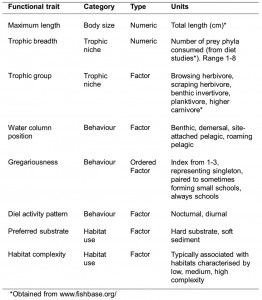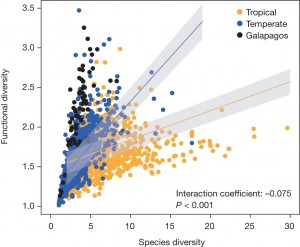Finding lots of Nemos
The article: Stuart-Smith, R.D. et al. (2013) Integrating abundance and functional traits reveals new global hotspots of fish diversity. Nature 501:539-542. doi:10.1038/nature12529
Subject areas: Ecology, Marine Biology
Vocabulary:
biodiversity – the amount of variation in living organisms within a particular ecosystem. This could be the number of different species within a particular forest, or it could the number of subspecies within a small insect colony.
—–
People like numbers. More is generally considered better. That kind of thinking has been the driving force in ecology and biodiversity policy not just for years, but even centuries. Perhaps that is because numbers is something politicians can relate to: X organisms saved for Y dollars. That doesn’t necessarily mean that this is a bad measure of biodiversity. But, as we learn more and more details about ecological systems, and as we have in other parts of biology, moved from purely descriptive to more mechanistic studies, it is clear that a more nuanced view of biodiversity may be possible.
What they did.
 Stuart-Smith and his colleagues have undertaken a global survey of reef fishes, focusing not just on the numbers of species as a measure of biodiversity, but looking for diversity in a number of different aspects that add up to functional diversity. These traits include body size, feeding ecology, behavior, and habitat use. The table of recorded characteristics is shown at right. The data were recorded by amateur volunteer scuba divers who had been trained by the research group. In all, data was gathered on 4357 transects (swaths of ocean covering a seafloor area of 50×10 meters, at a depth of approximately 7.4 meters.
Stuart-Smith and his colleagues have undertaken a global survey of reef fishes, focusing not just on the numbers of species as a measure of biodiversity, but looking for diversity in a number of different aspects that add up to functional diversity. These traits include body size, feeding ecology, behavior, and habitat use. The table of recorded characteristics is shown at right. The data were recorded by amateur volunteer scuba divers who had been trained by the research group. In all, data was gathered on 4357 transects (swaths of ocean covering a seafloor area of 50×10 meters, at a depth of approximately 7.4 meters.
The surveys were done on reefs all over the globe. While the average American reader probably thinks of the Great Barrier Reef in Australia or perhaps smaller coral reefs in the Caribbean Sea, you can see on the map below that the survey included reefs in the Arctic as well as along the coasts of all continents. A reef is any ocean or sea ridge that rises up near the level of the sea surface or just above it, and is made from a the inorganic remains of biological material. The figure below shows measures of species density (how many different species in a given area), functional group richness, species evenness (the number of individuals of each species), and finally functional diversity.
What they showed.
Comparing these maps, we can see that although there is a much higher species density and population in the tropical areas, species evenness is actually higher in the temperate zones than in the tropical ones. The data also showed that the relationship between species richness and functional diversity is fairly weak, suggesting to the authors that the conventional measure of reef “health” by species diversity may in fact be misleading because it does not take into account unequal representation of each species. Since the ecological effect of a species is proportional to abundance, the species richness approach could miss areas that may be on the verge of a decline in ecological health if the balance of species changes before the number of different species does.
A more detailed look at the data shows that there is also a difference between temperate and tropical zone reefs in the relationship between the species diversity vs the functional diversity (graph below). The authors interpret this as showing that the functional diversity hotspots in temperate regions are due to variation in individual fish rather than species, while functional diversity hotspots in tropical zones are could result from variation in either. Interestingly, the reefs in the Galapagos Archipelago have the most functionally diverse fish communities of all, regardless of species diversity.
Why it matters.
The current system of assessing ocean ecosystems strictly by species density does not give a complete picture of the state of the ecosystem. In some cases, it may even be wrong, if the functional diversity of an ocean reef system is a more accurate measure. This seems to be especially true of temperate zones, which have had much less emphasis placed on them compared to tropical regions. Current models of changing ocean biodiversity may be require adjustment, and with that, possible changes in policy to preserve that biodiversity.



No comments
Be the first one to leave a comment.